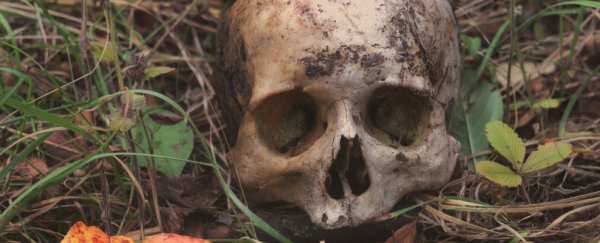According to new research, the dead may not always rest in peace… quite literally. For more than a year after death, corpses move around "significantly", and this finding could be important for forensic investigations.
Researchers at an Australia-based decomposition research facility - colloquially known as a "body farm", a term some scientists find disrespectful - made the startling discovery after using time-lapse cameras to film decomposing corpses.
For 17 months now, a camera at the Australian Facility for Taphonomic Experimental Research (AFTER) has been taking overhead images of a corpse every 30 minutes during daylight hours. And for the entire duration, the corpse continued to move.
"What we found was that the arms were significantly moving, so that arms that started off down beside the body ended up out to the side of the body," medical scientist Alyson Wilson of Central Queensland University told the Australian Broadcasting Corporation.
Some post-mortem movement was expected in the very early stages of decomposition, she explained, but the fact that it continued for the entire duration of filming was a complete surprise.
"We think the movements relate to the process of decomposition, as the body mummifies and the ligaments dry out," she said.
"This knowledge could be significant in unexplained death investigations."
In fact, it could change how scientists analyse and interpret crime scenes, particularly when human remains have been undiscovered for some time.
Until now, unless there was evidence that a body has been moved - either by animals or people - forensic scientists generally would assume that the position of a discovered body is the position at time of death.
Since Wilson's research is the first use of a time-lapse camera to study human decomposition, this is also the first evidence that the assumption about body position at death may not hold true.
A paper describing the discovery that corpses are rather more lively than expected has yet to be published, but it follows on from previous work, published in Forensic Science International: Synergy.
Wilson and colleagues used a time-lapse camera to track the decomposition of a corpse for six months. The resulting images were compared against a system of allocating points for levels of decomposition across the body to determine the post-mortem interval - how long the person had been dead.
The point system neatly matched the time-lapse photographs, adding to the system's validity as a forensic tool; additionally, the team's results validated the usefulness of time-lapse cameras in forensic research.
Based on these findings, it appears that if enough corpses are studied with long-term timelapses to generate statistical data on post-mortem movement, that knowledge could be used to analyse crime scenes with greater accuracy in the future.
Such a database would provide information on the ways in which people are likely to move, which in turn could allow forensic scientists to reconstruct the position the body was in at the time of death. In turn, that could help figure out what happened.
"They'll map a crime scene, they'll map the victim's body position, they'll map any physical evidence which is found, and they can understand the cause of death," Wilson told AFP.
